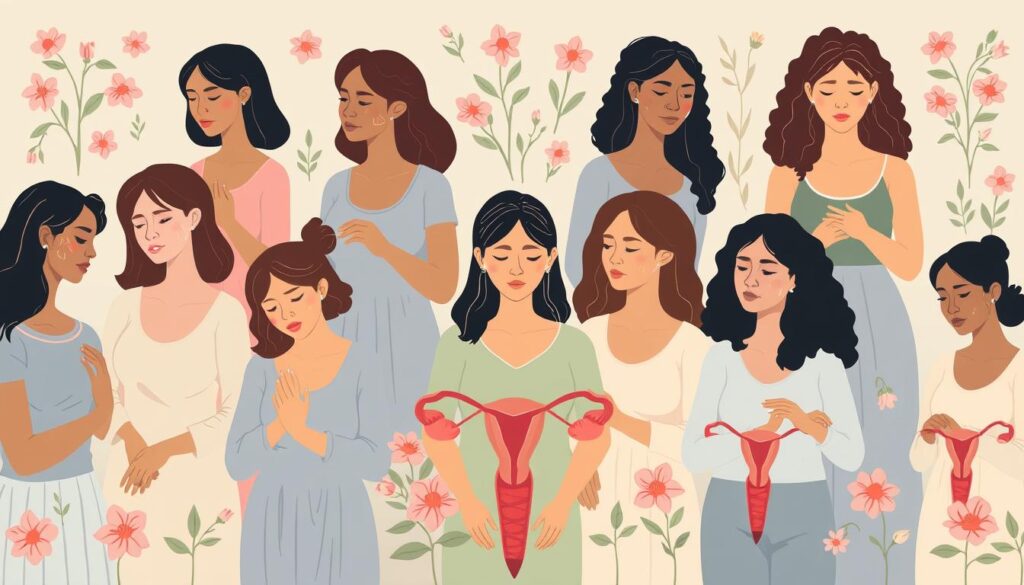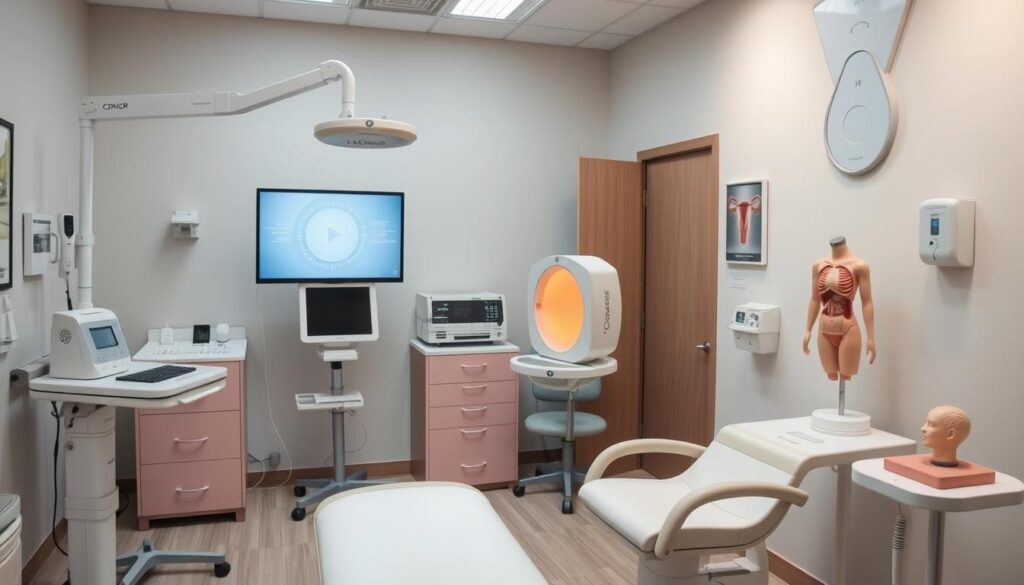Women’s health covers many topics, including gynaecological disorders. These issues affect the female reproductive system. They can greatly impact a woman’s life and health. It’s important to know about different gynaecological disorders, their symptoms, and treatments.
Gynaecological disorders vary from common issues like irregular periods and uterine fibroids to complex ones like endometriosis and PCOS. These can cause symptoms like pelvic pain, abnormal bleeding, and infertility. Early diagnosis and treatment are key to keeping women’s reproductive health in check.

Key Takeaways
- Gynaecological disorders are a diverse range of conditions that affect the female reproductive system.
- Understanding the various types of gynaecological disorders is crucial for maintaining optimal reproductive health.
- Common gynaecological disorders include endometriosis, PCOS, and uterine fibroids, each with their own unique symptoms and treatment approaches.
- Early diagnosis and appropriate treatment are essential for addressing gynaecological concerns and preserving women’s overall well-being.
- Regular check-ups and open communication with healthcare providers are key to managing gynaecological health.
Common Types of Gynaecological Disorders
Women’s reproductive health deals with many conditions, each with its own challenges. Endometriosis, polycystic ovary syndrome (PCOS), and uterine fibroids are among the most common. These conditions can greatly affect a woman’s life, making it important to know their causes, symptoms, and treatments.
Endometriosis and Its Impact
Endometriosis is a chronic condition where tissue grows outside the uterus. This tissue acts like the uterine lining, causing pain and bleeding. It can lead to severe pelvic pain, heavy bleeding, and infertility.
Polycystic Ovary Syndrome (PCOS)
PCOS is a hormonal disorder with cysts in the ovaries and hormone imbalances. It causes irregular periods, excessive hair, acne, and fertility issues. Women with PCOS are also at risk for diabetes, high blood pressure, and cancer.
Uterine Fibroids and Management
Uterine fibroids are non-cancerous growths in the uterine wall. They can cause heavy bleeding, pain, and reproductive problems. Treatment options range from medication to surgery, depending on the size and location of the fibroids.
| Condition | Prevalence | Symptoms | Potential Complications |
|---|---|---|---|
| Endometriosis | 6-10% of women of reproductive age | Pelvic pain Heavy, painful periods Painful intercourse Fatigue | Infertility Adhesions and scarring Chronic pelvic pain |
| PCOS | 5-10% of women of reproductive age | Irregular periods Excessive hair growth Acne Weight gain | Infertility Metabolic syndrome Increased risk of certain cancers |
| Uterine Fibroids | 20-80% of women by age 50 | Heavy, prolonged menstrual bleeding Pelvic pain and pressure Reproductive problems | Anemia Pregnancy complications Potential for growth and transformation |
These common gynaecological disorders can greatly affect a woman’s health and well-being. It’s important to understand each condition to get the right medical care and manage them effectively.
Signs and Symptoms of Female Reproductive Health Issues
Good women’s health is key, but many ignore the small signs of common gynaecological disorders. Spotting these signs early can help women get the medical help they need.
Irregular or painful periods are a big sign of a gynaecological issue. Menstrual disorders like heavy bleeding or unpredictable periods might mean endometriosis or PCOS.
Spotting between periods or after menopause is another warning sign. It could mean uterine fibroids or other pelvic problems. Also, pelvic pain that doesn’t go away can point to health issues.
- Irregular or painful menstrual cycles
- Abnormal vaginal bleeding
- Persistent pelvic pain
- Unusual vaginal discharge
- Difficulty conceiving or infertility
Other signs include unusual vaginal discharge, changes in sex life, and trouble getting pregnant. If you notice any of these, talk to a doctor right away.
“Paying attention to your body’s signals and seeking professional guidance can make all the difference in maintaining optimal women’s health.”
Knowing the signs of gynaecological disorders helps women take care of their reproductive health. They can get help early if they notice something off.

| Symptom | Potential Condition |
|---|---|
| Irregular or painful menstrual cycles | Endometriosis, PCOS |
| Abnormal vaginal bleeding | Uterine fibroids, cervical cancer |
| Persistent pelvic pain | Endometriosis, adenomyosis, pelvic inflammatory disease |
| Unusual vaginal discharge | Sexually transmitted infections, bacterial vaginosis |
| Difficulty conceiving or infertility | PCOS, endometriosis, uterine fibroids |
Diagnosis and Treatment Options for Pelvic Conditions
Diagnosing and treating pelvic conditions need a detailed approach. This includes medical exams, advanced tests, and specific treatments. We’ll look at how to manage gynecological and pelvic issues.
Medical Examination Procedures
A gynecologist starts with a thorough medical exam. This might include a pelvic exam to check the outside and inside of the body. They also do a Pap test to look for abnormal cells or cancer.
Advanced Diagnostic Technologies
Healthcare uses advanced tech to understand the condition better. This includes ultrasound and MRI to see inside the body. Sometimes, a laparoscopy is used to see and diagnose pelvic issues directly.
Treatment Approaches and Therapies
After finding the problem, doctors look at treatment options. This might include gynecological surgeries for issues like fibroids or endometriosis. For infertility treatments, IVF might be considered. Non-surgical methods like medicine or lifestyle changes also help manage conditions.
The right treatment depends on the diagnosis, how severe it is, and the patient’s health. Working with a healthcare team helps find the best way to treat pelvic conditions. This ensures a personalized and effective treatment plan.
Prevention and Early Detection Strategies
Keeping women’s health issues and female reproductive health in top shape is key. Taking proactive steps can really help. Regular check-ups and cervical cancer screening are vital for catching gynecological problems early.
Getting routine Pap smear tests is a smart move. This simple test can spot early signs of cervical cancer. Also, HPV testing can show your risk of cervical cancer.
- Scheduling annual gynecological exams with a healthcare provider
- Practicing good hygiene and maintaining a healthy lifestyle
- Reporting any unusual symptoms or changes to your healthcare provider
- Staying up-to-date with recommended cancer screening guidelines
Early detection is crucial for managing gynecological issues. Being proactive and informed about women’s health issues helps. This way, you can catch problems early and get the right treatment.

“Regular check-ups and screening tests can save lives by identifying problems early, when they are most treatable.”
Putting a focus on prevention and early detection helps women take charge of their health. By being vigilant and working with healthcare pros, you can manage female reproductive health well. This reduces the chance of serious gynecological issues.
Managing Menstrual Health and Fertility Concerns
Keeping menstrual and reproductive health in check is vital for women’s well-being. It’s important to understand irregular periods, explore fertility treatments, and balance hormones. This knowledge helps women manage their reproductive health effectively.
Understanding Menstrual Irregularities
Irregular periods, heavy bleeding, and cramps are signs of menstrual disorders. Conditions like menstrual disorders and endometriosis can really affect a woman’s life. Recognizing these signs and getting medical help early is key to finding the right treatment.
Fertility Treatment Options
For those dealing with infertility treatments, there are many options. These include medication and advanced reproductive technologies. Healthcare teams create custom plans to meet each person’s needs. This way, women can feel confident and supported on their journey to becoming parents.
Hormonal Balance and Wellness
Keeping hormones in balance is crucial for women’s health issues. Hormonal imbalances can lead to problems like PCOS, endometriosis, and infertility. By making lifestyle changes, using targeted therapies, and staying under medical watch, women can improve their hormonal health and overall well-being.
“Empowering women with knowledge and resources is key to navigating the complexities of reproductive health.”
Menopause and Gynaecological Health in Later Life
As women get older, menopause changes their gynaecological health a lot. This time can be tough, with symptoms and health worries. It’s key to know how to handle menopause to stay well.
Hormones change a lot during menopause, especially estrogen. This can cause hot flashes, night sweats, and dryness. Proper menopause management, like hormone therapy, can help. It makes life better for women.
It’s also important to keep gynaecological health in check. Regular doctor visits can spot and treat issues like fibroids or endometriosis. Catching problems early helps keep women healthy for a long time.
“Embracing the changes of menopause and prioritizing gynaecological health can empower women to navigate this transition with confidence and maintain their well-being in later life.”
Knowing about menopause and its effects on health helps women make good choices. They can find the right treatments and make lifestyle changes. This supports their health during this big life change.
Conclusion
In this detailed article, we’ve looked at the wide range of gynaecological disorders. We’ve covered the common types, their effects, and how to diagnose and treat them. We’ve learned about the challenges of endometriosis, PCOS, and uterine fibroids, and how they affect women’s health.
It’s important to know the signs and symptoms of these conditions. Early detection and care can greatly improve women’s health. Thanks to new medical tests and treatments, doctors can now offer more personalized care.
Prevention and early detection are key to keeping gynaecological health in check. By focusing on menstrual health, fertility, and hormonal balance, women can protect their reproductive health. This is especially true during menopause and beyond.
Inflammatory and Infectious Disorders
- Pelvic Inflammatory Disease (PID): Infection of the female reproductive organs, often caused by sexually transmitted bacteria.
- Endometritis: Inflammation of the lining of the uterus, often caused by infection.
- Vaginitis: Inflammation of the vagina, often caused by infection or hormonal changes.
Benign Growths and Tumors
- Uterine Fibroids: Non-cancerous growths in the uterus, often causing heavy bleeding, pain, and pressure.
- Ovarian Cysts: Fluid-filled sacs on the ovaries, often causing pain, bloating, and irregular periods.
- Polycystic Ovary Syndrome (PCOS): Hormonal disorder causing cysts on the ovaries, irregular periods, and infertility.
Menstrual and Hormonal Disorders
- Amenorrhea: Absence of menstruation, often caused by hormonal imbalances or structural abnormalities.
- Dysmenorrhea: Painful menstruation, often caused by hormonal imbalances or uterine abnormalities.
- Endometriosis: Growth of endometrial tissue outside the uterus, often causing pain, heavy bleeding, and infertility.
Cancerous Disorders
- Cervical Cancer: Cancer of the cervix, often caused by human papillomavirus (HPV) infection.
- Endometrial Cancer: Cancer of the lining of the uterus, often caused by hormonal imbalances or genetic mutations.
- Ovarian Cancer: Cancer of the ovaries, often caused by genetic mutations or hormonal imbalances.
Other Disorders
- Vulvodynia: Chronic pain or discomfort in the vulva, often caused by nerve damage or hormonal imbalances.
- Prolapse: Sagging or falling of the uterus, bladder, or rectum into the vagina, often caused by weakened pelvic muscles.
- Urinary Incontinence: Loss of bladder control, often caused by weakened pelvic muscles or nerve damage.
FAQ
Q: What are the most common types of gynaecological disorders?
A: Common gynaecological disorders include endometriosis, PCOS, and uterine fibroids. These can affect a woman’s reproductive health and overall well-being.
Q: What are the typical signs and symptoms of gynaecological issues?
A: Signs and symptoms include irregular periods, pelvic pain, abnormal bleeding, and infertility. If you notice any unusual changes, seek medical help.
Q: How are gynaecological disorders diagnosed and treated?
A: Diagnosis involves medical exams, imaging tests, and sometimes advanced technologies. Treatment varies by condition and may include medications or surgery. Your doctor will help choose the best treatment for you.
Q: What can be done to prevent and detect gynaecological disorders early?
A: Regular check-ups and screenings are key. A healthy lifestyle also helps. Being proactive about your health can lead to early detection and treatment.
Q: How can menstrual health and fertility concerns be addressed?
A: Understanding the causes of menstrual irregularities and fertility issues is crucial. Your doctor can help diagnose and recommend treatments, including fertility options.
Q: What are the key considerations for women’s health during menopause?
A: Menopause brings changes like hormone shifts and vaginal dryness. Managing symptoms with hormone therapy can help maintain health during this time.
